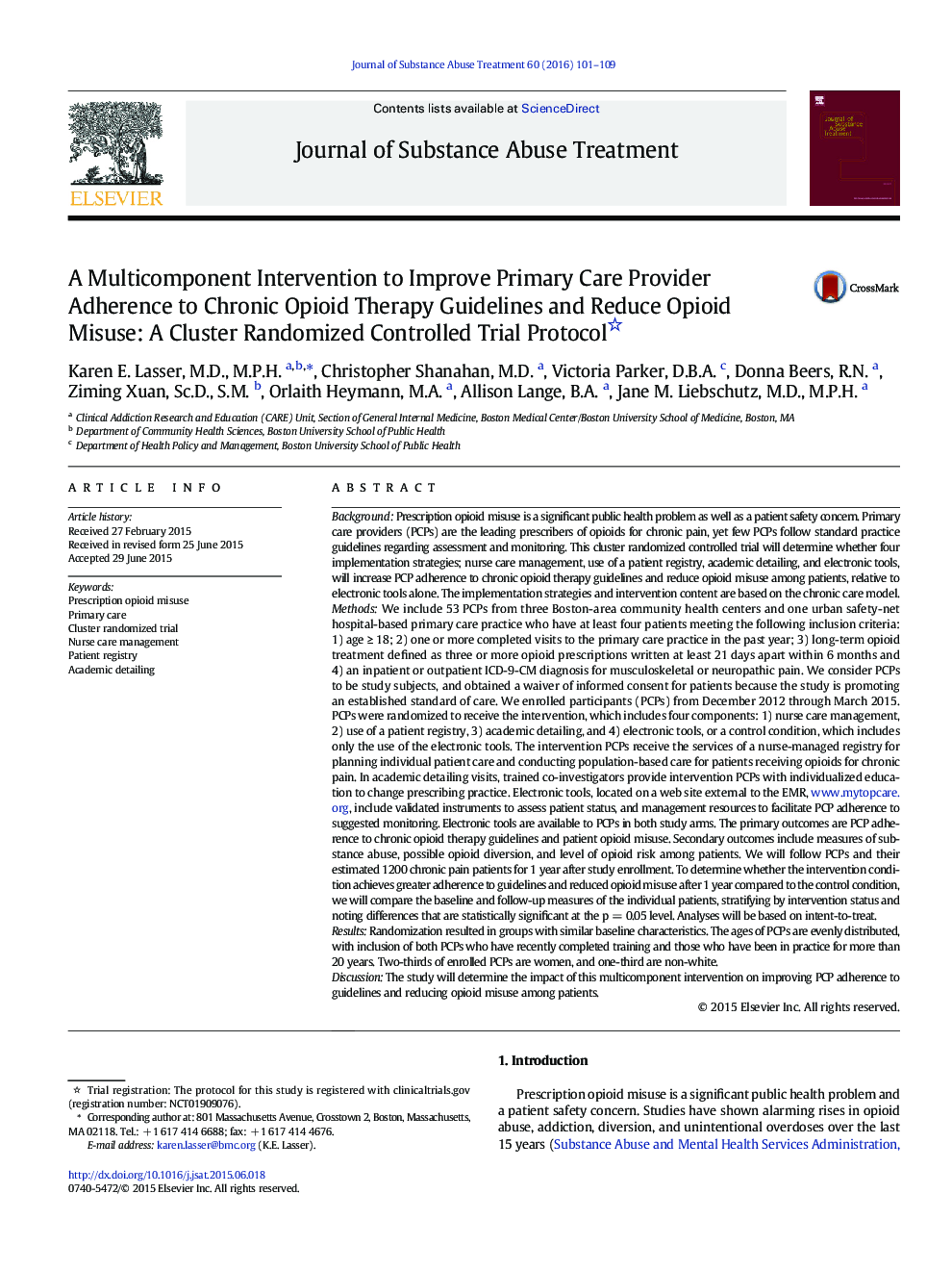| کد مقاله | کد نشریه | سال انتشار | مقاله انگلیسی | نسخه تمام متن |
|---|---|---|---|---|
| 328409 | 543220 | 2016 | 9 صفحه PDF | دانلود رایگان |
• Present the protocol of a cluster randomized controlled trial testing the effectiveness of nurse care management, use of a patient registry, academic detailing, and electronic tools, relative to electronic tools only, to promote PCP adherence to chronic opioid therapy guidelines and reduce patient opioid misuse
• Present baseline data on PCPs enrolled to date
BackgroundPrescription opioid misuse is a significant public health problem as well as a patient safety concern. Primary care providers (PCPs) are the leading prescribers of opioids for chronic pain, yet few PCPs follow standard practice guidelines regarding assessment and monitoring. This cluster randomized controlled trial will determine whether four implementation strategies; nurse care management, use of a patient registry, academic detailing, and electronic tools, will increase PCP adherence to chronic opioid therapy guidelines and reduce opioid misuse among patients, relative to electronic tools alone. The implementation strategies and intervention content are based on the chronic care model.MethodsWe include 53 PCPs from three Boston-area community health centers and one urban safety-net hospital-based primary care practice who have at least four patients meeting the following inclusion criteria: 1) age ≥ 18; 2) one or more completed visits to the primary care practice in the past year; 3) long-term opioid treatment defined as three or more opioid prescriptions written at least 21 days apart within 6 months and 4) an inpatient or outpatient ICD-9-CM diagnosis for musculoskeletal or neuropathic pain. We consider PCPs to be study subjects, and obtained a waiver of informed consent for patients because the study is promoting an established standard of care. We enrolled participants (PCPs) from December 2012 through March 2015. PCPs were randomized to receive the intervention, which includes four components: 1) nurse care management, 2) use of a patient registry, 3) academic detailing, and 4) electronic tools, or a control condition, which includes only the use of the electronic tools. The intervention PCPs receive the services of a nurse-managed registry for planning individual patient care and conducting population-based care for patients receiving opioids for chronic pain. In academic detailing visits, trained co-investigators provide intervention PCPs with individualized education to change prescribing practice. Electronic tools, located on a web site external to the EMR, www.mytopcare.org, include validated instruments to assess patient status, and management resources to facilitate PCP adherence to suggested monitoring. Electronic tools are available to PCPs in both study arms. The primary outcomes are PCP adherence to chronic opioid therapy guidelines and patient opioid misuse. Secondary outcomes include measures of substance abuse, possible opioid diversion, and level of opioid risk among patients. We will follow PCPs and their estimated 1200 chronic pain patients for 1 year after study enrollment. To determine whether the intervention condition achieves greater adherence to guidelines and reduced opioid misuse after 1 year compared to the control condition, we will compare the baseline and follow-up measures of the individual patients, stratifying by intervention status and noting differences that are statistically significant at the p = 0.05 level. Analyses will be based on intent-to-treat.ResultsRandomization resulted in groups with similar baseline characteristics. The ages of PCPs are evenly distributed, with inclusion of both PCPs who have recently completed training and those who have been in practice for more than 20 years. Two-thirds of enrolled PCPs are women, and one-third are non-white.DiscussionThe study will determine the impact of this multicomponent intervention on improving PCP adherence to guidelines and reducing opioid misuse among patients.
Journal: Journal of Substance Abuse Treatment - Volume 60, January 2016, Pages 101–109
